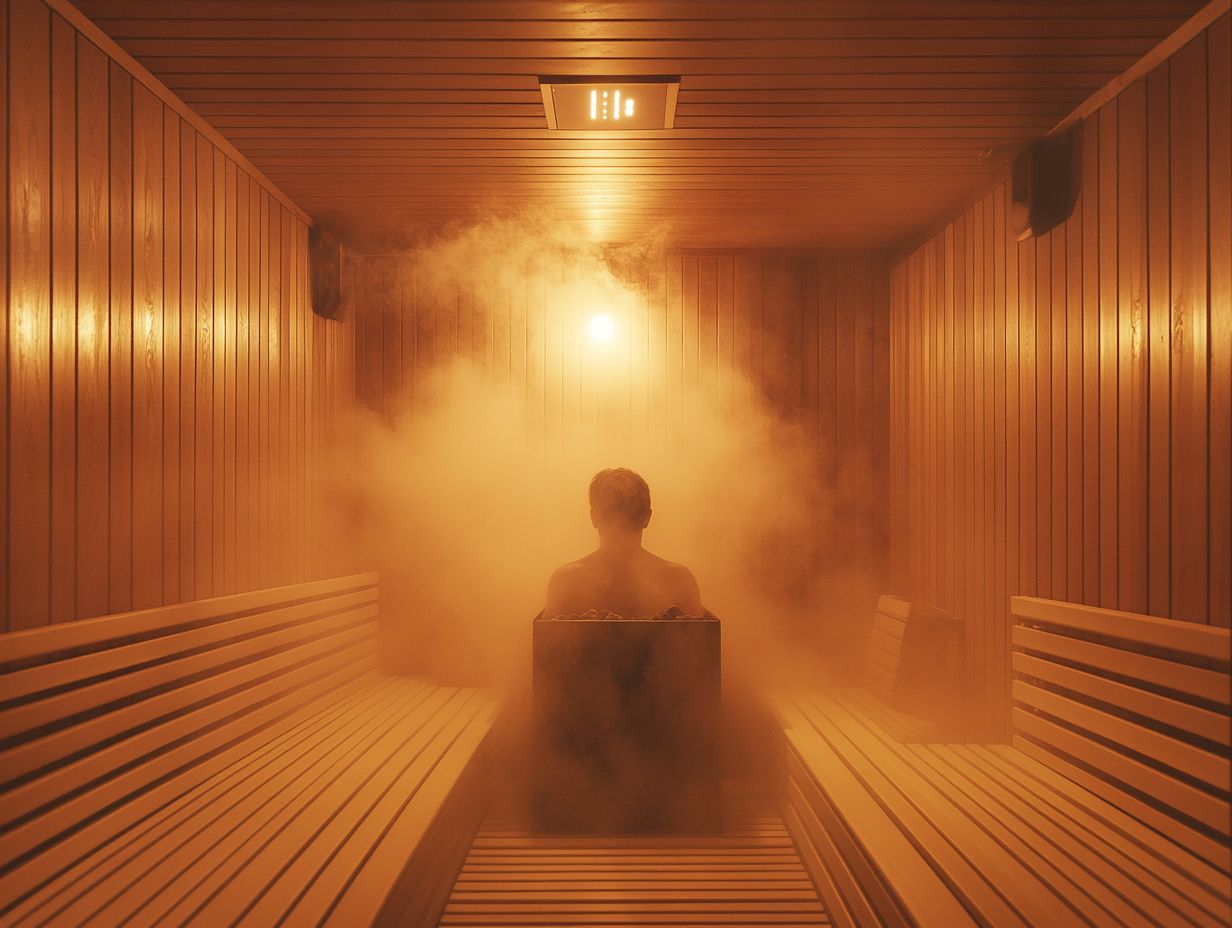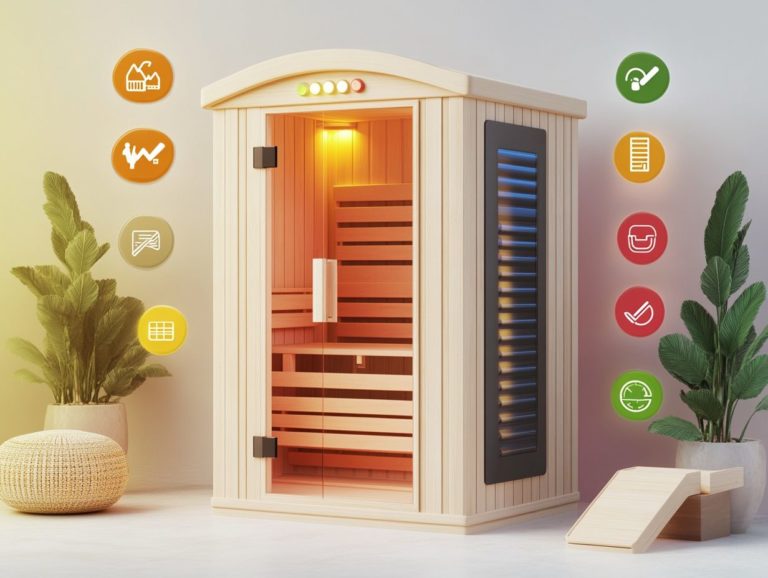The Risks of Extended Sauna Sessions
Sauna sessions can provide a luxurious escape, delivering a wealth of health benefits, including detoxification and enhanced circulation. They also promote relaxation and muscle recovery.
Spending too much time in the heat can lead to risks that are often overlooked, such as heat exhaustion, dehydration, and potential impacts on heart health.
This article delves into what a sauna truly is, the dangers associated with extended use, including risks related to dehydration and joint pain, and various factors that may heighten these risks.
You ll find essential precautions, such as hydration tips and relaxation techniques, to ensure a safe experience. We will also discuss alternative options if extended sessions are not suitable for you.
Contents
- Key Takeaways:
- Understanding Sauna Sessions
- Potential Risks of Extended Sauna Sessions
- Factors that Increase Risk
- Precautions to Take During Sauna Sessions
- Alternatives to Extended Sauna Sessions
- Frequently Asked Questions
- What are the risks of extended sauna sessions?
- How long is considered an extended sauna session?
- What are the signs of overheating during a sauna session?
- Can extended sauna sessions be harmful for pregnant women?
- Are there any long-term risks associated with extended sauna sessions?
- How can I mitigate the risks of extended sauna sessions?
Key Takeaways:

- Extended sauna sessions can lead to heat exhaustion, dehydration, and increased muscle soreness. It s important to stay hydrated and take cooling breaks.
- Individual factors such as blood pressure, chronic pain, and heart health can increase the risks of extended sauna use. Consult with a healthcare professional before starting a sauna regimen.
- There are alternative heat-based therapies that can provide similar benefits without the potential risks of extended sauna sessions, such as infrared saunas, steam saunas, or hot stone massages. These options appeal to both first-time users and seasoned enthusiasts.
Understanding Sauna Sessions
Understanding sauna sessions requires diving into the different types of saunas, including infrared saunas, steam saunas, and traditional saunas. Each offers numerous health benefits, such as relaxation, detoxification, and improved cardiovascular health.
Saunas have long been a cornerstone of wellness practices, tracing their roots back to Finland, where they re revered for fostering emotional well-being and physical recovery. They have gained popularity among celebrities seeking relaxation.
Whether you opt for an infrared sauna, a steam sauna, or a traditional sauna, each provides a unique experience. This allows you to customize your session to align with your personal preferences and health objectives.
By ensuring you stay properly hydrated and mindful of the recommended duration for use, you can significantly elevate your overall wellness.
What is a Sauna?
A sauna is a cozy retreat designed for indulging in dry or wet heat sessions. These often feature infrared heaters, steam, or traditional heating methods to elevate your body temperature.
These sessions create a serene atmosphere while offering numerous health benefits. For example, infrared saunas penetrate the skin more deeply, enhancing detoxification, promoting muscle relaxation, and providing relief for those with chronic pain and skin conditions like acne and psoriasis.
Traditional Finnish saunas present high temperatures and low humidity, encouraging your body to sweat profusely. This not only aids in flushing out toxins but also improves blood circulation and promotes skin health.
Engaging in regular sauna use can enhance skin health, assisting in conditions like acne. The sweating process opens your pores, allowing for better exfoliation and a luminous complexion.
Potential Risks of Extended Sauna Sessions
While sauna sessions provide numerous health benefits, including stress relief and muscle recovery, it s important to recognize that spending too much time can carry certain risks, such as dehydration and impacts on breathing.
Potential issues include dehydration, heat exhaustion, and fluctuations in blood pressure, especially if you have pre-existing heart conditions or respiratory diseases.
Be mindful while enjoying your sauna experience it can make all the difference! Adhere to health precautions and remain aware of your body s limits.
We invite you to share your sauna experiences or tips in the comments below!
Heat Exhaustion and Dehydration
Heat exhaustion poses a significant risk during sauna sessions, especially if you don t follow recommended durations, hydration strategies, and body temperature monitoring.
You might experience symptoms like excessive sweating, dizziness, rapid heartbeat, fatigue, and muscle cramps, so stay aware of how your body reacts to the heat. Proper hydration is key to preventing heat-related issues; drinking enough water before, during, and after your sauna experience helps maintain your body s fluid balance.
Remember these key tips to stay safe while enjoying your sauna!
- Take small sips of water regularly.
- Consider indulging in electrolyte-enriched beverages.
- Steer clear of alcohol or caffeine before stepping into the sauna.
By following these practical tips, you can minimize your risk of heat exhaustion and fully enjoy the myriad health benefits that saunas provide.
Impact on Blood Pressure and Heart Health

Sauna use can greatly affect your blood pressure and heart health, presenting both benefits and risks based on your health factors. For many, regular sauna sessions can lead to lower blood pressure, better circulation, and improved cardiovascular function, easing the strain on the heart over time. If you have existing heart conditions, consult your doctor before using a sauna.
While the heat can induce relaxation and offer temporary enhancements in vascular health, spending too long in the heat or exposing yourself to excessively high temperatures could result in complications. Always consult a healthcare professional to ensure you reap the benefits while minimizing potential health risks.
Factors that Increase Risk
Factors like the duration and frequency of your sauna sessions can increase risks. Your health conditions, such as chronic pain or cardiovascular conditions, can determine how safe sauna use is for you.
Duration and Frequency of Sauna Use
The duration and frequency of your sauna sessions are key factors in unlocking health benefits while minimizing risks. The right duration depends on your personal tolerance and health status.
Experts generally recommend sauna visits last between 15 to 20 minutes, allowing enough time to unwind and reap cardiovascular benefits. Aim for two to three sessions each week for improved circulation, detoxification, and stress relief, contributing to better cardiovascular health.
Exceeding 30 minutes in a single session could elevate your risk of dehydration and overheating. If you have pre-existing conditions, such as cardiovascular issues or respiratory disorders, consult a healthcare professional to ensure both safety and effectiveness.
Individual Health Factors
Your health conditions, such as chronic pain or cardiovascular diseases, can significantly shape your approach to sauna use. If you have hypertension or heart issues, consult your doctor before using a sauna, as elevated temperatures could worsen your condition.
Those dealing with respiratory problems like asthma or chronic obstructive pulmonary disease (COPD) might find that heat and humidity trigger their symptoms rather than soothe them. If you have skin conditions like eczema or psoriasis, tread carefully; the heat could lead to increased irritation.
To enhance your safety, consider keeping your sauna sessions shorter and ensuring you stay well-hydrated, especially if you have pre-existing health concerns. Enjoy your sauna sessions safely and feel the benefits!
Precautions to Take During Sauna Sessions
Taking the right precautions during your sauna sessions is essential for both safety and maximizing health benefits, especially for first-time users.
Key strategies to consider include:
- Staying well-hydrated
- Employing effective cooling techniques
- Keeping a close eye on your body temperature
Hydration and Cooling Strategies

Implementing effective hydration and cooling strategies during your sauna sessions is crucial. This approach helps prevent dehydration, joint pain, and maintains a comfortable body temperature.
Prioritize your water intake before, during, and after the sauna to enhance comfort, support healthy skin, and reduce the risk of overheating. Aim to drink at least 500 milliliters of water before stepping into the sauna. Sipping on electrolytes can also replenish vital minerals you may lose.
Taking periodic breaks to cool down by stepping outside or using cold compresses will help regulate your body temperature. Using a timer to limit sauna sessions to 15-20 minutes and opting for lower temperatures or infrared options makes heat exposure more manageable.
Monitoring Body Temperature and Health Indicators
Monitoring your body temperature and other health indicators is essential during sauna sessions. This practice helps you avoid potential health risks and ensures a safe experience.
Consider using a digital thermometer or smartwatch that tracks real-time variations in body temperature. Stay informed about how your body responds to the heat, especially in the intense environment of a sauna. Pay attention to signs like dizziness, nausea, or excessive sweating, as they provide valuable insight into your health status.
Act quickly! If you feel dizzy or unwell, exit the sauna immediately, cool down, and hydrate to prevent adverse effects.
Alternatives to Extended Sauna Sessions
If you’re looking for alternatives to long sauna sessions, various heat-based therapies can provide similar health benefits and relaxation while minimizing the risks tied to extended sauna use.
Other Heat-Based Therapies
Other heat-based therapies, such as infrared therapy and hot stone massages, offer effective relaxation techniques and health benefits similar to traditional sauna sessions, including relief from muscle soreness.
These therapies use various forms of heat to relieve muscle tension, boost circulation, and enhance detoxification. Infrared therapy employs radiant heat that penetrates the skin more deeply than conventional methods, stimulating metabolic processes and providing pain relief.
Hot stone massages utilize strategically placed heated stones on your body. The warmth melts away muscle stiffness and instills a sense of tranquility.
By combining these alternatives, you gain convenience and options that cater to individual preferences, making them valuable for anyone seeking relaxation and wellness without the constraints of a sauna.
Frequently Asked Questions
What are the risks of extended sauna sessions?

Extended sauna sessions can lead to dehydration, overheating, and even heat stroke. They can also aggravate existing medical conditions like high blood pressure and heart disease.
How long is considered an extended sauna session?
An extended sauna session is typically more than 20 minutes. However, the duration can vary based on individual tolerance and the type of sauna being used.
What are the signs of overheating during a sauna session?
Signs of overheating include:
- Dizziness
- Nausea
- Excessive sweating
- Feeling faint
Listen to your body and take breaks as needed.
Can extended sauna sessions be harmful for pregnant women?
Yes, extended sauna sessions can be harmful to pregnant women. They can raise the body temperature to dangerous levels for both the mother and the baby.
It is best to avoid saunas during pregnancy to ensure safety.
Are there any long-term risks associated with extended sauna sessions?
Frequent sauna use may lead to skin issues like eczema and psoriasis. It can also put extra strain on your heart, potentially leading to heart problems over time.
How can I mitigate the risks of extended sauna sessions?
To lower these risks, drink plenty of water before, during, and after your sauna session. Always listen to your body and take breaks when you need them.
If you have any medical conditions, talk to your doctor before using a sauna.





